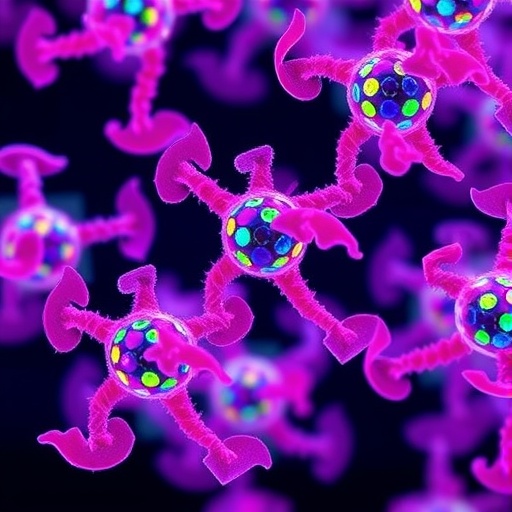In a groundbreaking advancement in molecular biology, researchers from Tokyo Metropolitan University have unveiled a novel methodology using Nuclear Magnetic Resonance (NMR) spectroscopy that enables unprecedented insights into the dynamic movements of enzymes at the atomic scale. This innovative approach captures the elusive, rapid conformational changes that occur as enzymes catalyze biochemical reactions—movements that have long remained veiled by the static snapshots offered by conventional structural techniques such as X-ray crystallography or cryo-electron microscopy.
Enzymes, the molecular workhorses essential to life’s biochemical processes, have traditionally been studied through structure determination methods that yield fixed, static images. While these images have fundamentally advanced our understanding of protein architecture, they present an incomplete picture, as enzymes are inherently dynamic entities. Their structures incessantly fluctuate, adopting multiple conformations that are crucial for binding substrates, facilitating chemical transformations, and regulating activity. Capturing such fleeting and subtle motions—occurring on nanometer scales and milliseconds timescales—remains a formidable challenge in structural biology.
Addressing this gap, the team led by Associate Professor Teppei Ikeya has harnessed the power of NMR spectroscopy, an approach uniquely suited to probe molecular motions over a range of timescales in native-like environments. By integrating a suite of complementary NMR techniques, the researchers produced a high-resolution “ensemble structure” of a key enzyme, offering a probabilistic landscape describing how the protein’s conformation fluctuates and what states it preferentially adopts during catalysis. This ensemble perspective shifts the paradigm from single fixed structures towards a more authentic representation of biological reality.
Focusing their investigations on yeast ubiquitin hydrolase 1 (YUH1), an enzyme critical for recycling ubiquitin—a regulatory protein modulating intracellular processes—the team demonstrated their method’s capability to elucidate enzyme dynamics with remarkable clarity. Intriguingly, they mapped the millisecond-timescale motions of YUH1, revealing substantial flexibility in two vital regions proximal to the enzyme’s active site: a “crossover loop” structure and the protein’s N-terminus. These regions exhibited coordinated movements that orchestrate substrate recognition and binding.
The dynamic interplay of the N-terminus and crossover loop was found to function in a novel gating mechanism. The N-terminus acts like a lasso, moving in and out of the loop through various intermediate conformations before securely capturing the target protein. This flexible “gating lid” then maintains substrate engagement, facilitating efficient catalytic activity. Mutational analyses further corroborated this model—alterations impairing the gating lid’s completeness caused diminished enzymatic function, underscoring the critical role of these dynamic structural elements.
Beyond detailing the intricate operation of YUH1, this research highlights the broader significance of enzyme dynamics for biological function. Proteins previously viewed as rigid structures are instead revealed as dynamic mosaics, whose fluctuating configurations are integral to their mechanistic roles. Such insights carry profound implications, particularly for enzymes with human homologues implicated in neurodegenerative diseases, such as ubiquitin C-terminal hydrolase (UCHL1) linked to Parkinson’s and Alzheimer’s disorders.
The ability to capture these molecular theaters in motion through NMR-based ensemble mapping offers scientists a revolutionary tool. Unlike it crystallographic methods that often require non-native conditions or static trapping, this approach permits interrogation of biomolecules within solution environments approximating physiological states. Consequently, it holds promise for unraveling the elusive mechanisms of molecular recognition, allosteric regulation, and enzyme catalysis as they naturally occur in living cells.
Technically, the approach involves combining multiple pulse sequences and relaxation dispersion experiments to quantify exchange rates between conformational states. Sophisticated computational algorithms then integrate the heterogeneous NMR data, reconstructing a multidimensional free energy landscape. This ensemble offers a statistical distribution of conformations, weighted by their relative populations and exchange kinetics, providing a rich tapestry of structural and dynamical information far beyond traditional single-state models.
Such multidimensional characterization could drive transformative strides in drug discovery and bioengineering. Understanding how enzymes harness conformational plasticity to regulate activity offers strategies to design molecules that modulate these dynamics selectively. Moreover, capturing the structural ensembles of disease-related proteins could illuminate pathological misfolding or aberrant dynamics, guiding therapeutic interventions at unprecedented molecular detail.
The research was supported by Japan’s Funding Program for Core Research for Evolutional Science and Technology (CREST), the Japan Society for the Promotion of Science (JSPS), the Shimadzu Foundation, and the Precise Measurement Technology Promotion Foundation. Their experiments were performed at the NMR Platform under the Ministry of Education, Culture, Sports, Science and Technology (MEXT) program, ensuring state-of-the-art instrumentation and expertise were leveraged in this pioneering work.
By providing a window into the dynamic life of enzymes, this study paves a new avenue in structural biology, shifting the community’s perspective from static snapshots to dynamic ensembles. It bridges the gap between form and function, revealing how subtle atomic-scale motions choreograph the essential biological processes underlying health and disease. As this methodology is expanded to diverse biomolecular systems, it promises to unlock fundamental mysteries of molecular biology and open new frontiers in understanding life at its most intricate levels.
The future of structural biophysics will undoubtedly be shaped by techniques that reveal dynamics in biologically relevant contexts. NMR spectroscopy, with its unique ability to probe motional hierarchies and conformational equilibria, stands at the forefront of this revolution. Tokyo Metropolitan University’s work exemplifies how integrating experimental innovation with theoretical rigor can redefine our conceptual frameworks, offering scientific insights that resonate across disciplines and inspire transformative discoveries in life sciences.
Subject of Research: Enzyme dynamics and structural determination using Nuclear Magnetic Resonance (NMR) spectroscopy.
Article Title: Multistate Structure Determination and Dynamics Analysis Reveals a Unique Ubiquitin-Recognition Mechanism in Ubiquitin C-terminal Hydrolase
News Publication Date: 6-Aug-2025
Web References:
http://dx.doi.org/10.1021/jacs.5c06502
Image Credits: Tokyo Metropolitan University
Keywords
Protein analysis, Protein activity, Nuclear magnetic resonance, Biomolecular structure, Protein structure, Biochemical analysis, Molecular recognition, Enzymatic activity




